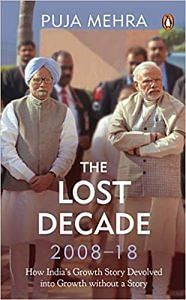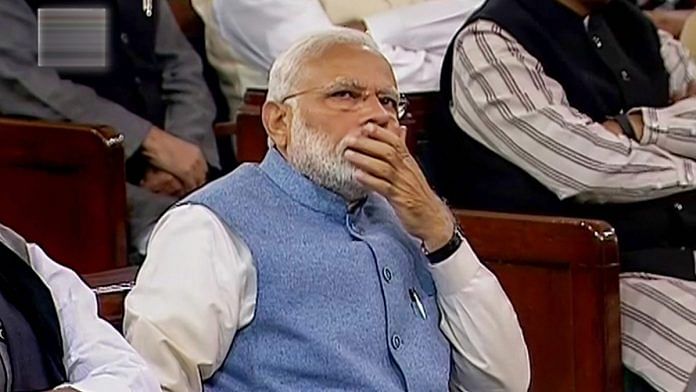The budget, trading in ideologies for pragmatism, reprised the Nehruvian strategy for growth: building physical capital with public investments.
Finance Minister Arun Jaitley allocated Rs 70,000 crore for roads and railways. The Modi government had chosen to ignore the investment slowdown and the twin balance sheet problem that was guaranteed to blow up into an NPA crisis. It decided to concentrate its energies instead on an infrastructure push. The architect of this plan for accelerating growth was Chief Economic Adviser Arvind Subramanian.
Subramanian’s infrastructure push was not altogether a new idea. The difference lay in its funding strategies. The UPA government too had wanted to focus on creation of physical capital as a source of growth, but with a role for the private sector. Its preferred model of financing infrastructure development, as enshrined in the Twelfth Plan document, were public-private partnerships (PPP). During Pranab Mukherjee’s term in North Block in particular, PSBs were encouraged to lend for infrastructure projects. That ‘asset stimulus’ was, in part, responsible for the growing NPA problem and its economy-wide consequence—an investment slowdown. Now, balance sheets of both banks and borrowers were reeling under mountains of unpaid debt. The stress on corporate balance sheets ruled out PPPs. The challenge was that companies had no money to invest. The Modi government took recourse to tax money for its plans of infrastructure building—going against the counsel of the IMF that had cautioned of the ineffectiveness of a fiscal push for strengthening the economic recovery underway and recommended a strategy comprising reform instead.
Also read: Narendra Modi may not like Jawaharlal Nehru, but still wants to be like him
Following Subramanian’s proposition, the Modi government stepped up its public investments, even deferring fiscal deficit targets, but the decline in private investments was so sharp that the increases in government investments could not offset it. The stimulus Subramanian designed — Rs 70,000 crore of public investment for building infrastructure to stimulate private investments—proved insufficient to generate the growth impulses needed to kick-start the over $2 trillion economy and rekindle the animal spirits numbed by policy paralysis and corruption scandals during the UPA’s second stint.
The steps taken for improving the ease of doing business and the foreign investments regime proved insufficient for restarting the private investment cycle. Private investments remained unresponsive to the macroeconomic stimulus administered through budget allocations. Decreasing for the fifth straight year, the share of gross fixed capital formation in GDP shrunk to 27.1 per cent in 2016–17. It had been 34.3 per cent in 2011–12.
No major growth push materialized, even as the investment climate soured further. The private investments could not have revived with the twin balance sheet problem remaining unresolved.
The brewing NPA crisis was being flagged in every review and agenda-setting meeting at the PMO and the finance ministry. Financial Services Secretary Hasmukh Adhia’s presentation to the prime minister detailed in the strongest possible terms the crying need for corrective action in PSBs: the quicker the banking sector recovered its health, the speedier a pullback in the overall economy could be expected. It was clear that the stress, if unattended, would limit the effectiveness of the monetary support of lower interest rates — the Reserve Bank would go on to announce cuts adding up to 125 basis points in twelve months in its key interest rate.
The finance ministry officials, including the government’s own publication, the Economic Survey, would routinely caution about the ‘twin balance sheet problem’.
But the government was not moved to show the urgency needed to address the mess. The banks’ capital buffers kept depleting as the loan defaults rose and NPAs aged. When capital is provided, there is enough to cover losses and finance credit growth. Growth in credit, in turn, creates profit that can be ploughed back in to capital. But after RBI’s AQR led to NPAs becoming unhidden, the government did not move swiftly to provide capital. In August 2015, it announced an infusion of Rs 70,000 crore over a four-year period. Next, as late as October 2017, it announced further infusion of Rs 1.35 trillion. Again, not in one go but spread over time. And therefore the infusions could only cover losses. In fact, 70 per cent of capital infusion was absorbed into losses. The recapitalization could not therefore provide for credit growth that may have generated profits. Banks and borrowers both lost out.
Also read: Maximum schemes, minimum welfare: How the Modi govt fell into the same trap as UPA
Bank lending to industry had grown in excess of 20 per cent year on year during 2006–11.
The capital infusion announced by the government was a small fraction of the estimates the IMF and ratings agencies such as Fitch had said would be needed to get the banking sector on an even keel.
The projections quoted earlier in the IMF’s stress tests for the banks’ capital position in the event of sudden deterioration had thrown up startling numbers. But the peril of severe capital erosion of banks failed to move the government on the banks’ problems. The government’s dithering proved costly for the economy. Banks’ lending capacities remained restricted. The credit crunch further choked private investments, and the economic recovery under way was stalled — the third time a recovery was destroyed.
The IMF’s annual Article IV consultations report issued in March 2016 flagged the NPA issue:
Public Sector Banks’ capital needs are estimated to account for 2.9 per cent of (2018-19) GDP (cumulatively over the next four years) . . . Full recognition of risks on PSBs’ balance sheets, adequate capitalization, and further governance reforms are critical for strengthening the banking sector going forward.
Thankfully, the ‘most severe case’ scenario of the IMF’s earlier projections had not materialized, but fundamental reform of the banking sector was needed on a war footing. Without reforms, any other action would have been like standing at Chernobyl and seeing they’ve restarted the reactor but still have the same old management.
 This excerpt from ‘The Lost Decade (2008-18): How India’s Growth Story Devolved into Growth Without a Story’ has been published with permission from Penguin Random House India.
This excerpt from ‘The Lost Decade (2008-18): How India’s Growth Story Devolved into Growth Without a Story’ has been published with permission from Penguin Random House India.



